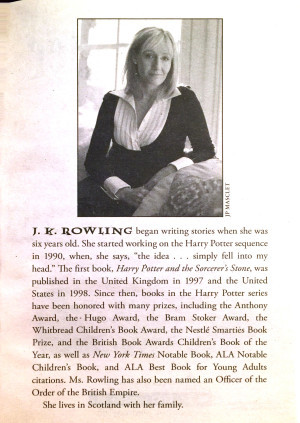Write Your Bio (a.k.a. an answer for Michael Beverly)

What was her first bio?
In addition to ripping off chunks off Shawn’s work last week, I’ve stolen his spot this week to answer a question from Michael Beverly (See Michael’s full question in last Friday’s comments section.)
Do I think an author bio is necessary for a fiction author?
Necessary? No.
A good idea? Yes.
When I started writing tip-sheet (one-pagers about a book) copy for sales conferences, I learned how much bios play into sales.
The sales reps used these tip sheets to help sell the new season to book buyers.
Without having read the books, the reps would make decisions on which books to emphasize most during sales calls, based on two things: marketing/PR plans and author bios. The reps wanted the first bit because they knew it would grab the buyers’ attention — to confirm sales would be fueled. They wanted the second bit — the bio — to confirm the author had the chops and/or to fuel local sales.
Let’s break down the local and the chops.
For local, the idea was that the sales reps would push local sales if they knew where the authors lived – and that local buyers would be more inclined to buy and feature books by local authors. For established authors, this information wasn’t a must-have, but for first-time/emerging authors, the local angle was one to work. Same holds true today. Sharing where you’re from, where you live, is an opportunity to connect with readers in those communities.
For chops… On the non-fiction front, the sales reps and book buyers wanted credentials that stated why readers would want to buy a specific book from a specific author. For example, for a book about the treatment and prevention of Diabetes, the reps and buyers wanted to know that the author was a doctor who specialized in Diabetes research, treatment and prevention. Why would readers buy that Diabetes book instead of one of the many other books about Diabetes? Well, because it was written by a doc residing at the top of the field.
For fiction, the focus was different. If credentials that fed into the subject of the books were available, they would be used as selling points.
For example, Myke Cole’s bio for his book Gemini Cell is:
As a security contractor, government civilian, and military officer, Myke Cole’s career has run the gamut from counterterrorism to cyber warfare to federal law enforcement. He’s done three tours in Iraq and was recalled to serve during the Deepwater Horizon spill. All that conflict can wear a guy out. Thank goodness for fantasy novels, comic books, late-night games of Dungeons & Dragons, and lots of angst-fueled writing.
If the authors’ day jobs, and/or past experiences, aren’t a fit, their interests hit next. Here’s an example from my kids’ bookshelf:
Erin Hunter is inspired by a love of cats and a fascination with the ferocity of the natural world. As well as having a great respect for nature in all its forms, Erin enjoys creating rich, mythical explanations for animal behavior, shaped by her interest in astrology and standing stones.
*Michael mentioned using a pen name, so I’m hoping he’ll check out Erin Hunter’s site. Erin is actually six different people: Kate Cary, Cherith Baldry, Tui Sutherland, Gillian Philip, Inbali Iserles and Victoria Holmes.
The interest-driven bio is a good approach for the first-time author.
I tried to find J.K. Rowling’s bio for the first edition of Harry Potter online, to see if it mentioned a love of wizards or if it relied on the penniless, divorced mother description than ran in early interviews with her. It would be interesting to know what was in the early bio, to compare it to later editions.
I’d like to know Lauren Weisberger’s bio for the first edition of The Devil Wears Prada, too. The bio in the mass market edition relies on the previous success of the title and features an image from the movie on the cover:
Lauren Weisberger graduated from Cornell University. Her first novel, The Devil Wears Prada, was on the New York Times bestseller list for six months. It has been published in twenty-seven countries. Weisberger lives in New York City.
Another book-to-movie example is from W.P. Kinsella’s book Shoeless Joe, for an edition released after the movie:
W.P. Kinsella is the author of the novel The Iowa Baseball Confederacy and eleven collections of short stories, including Go the Distance. He lives in the Pacific Northwest.
Outside of location, chops and interests, the one other item that authors need for their bios? Their site — or their page on their publisher’s site.
Mike Lupica’s bio, for The Only Game, hits on his career highlights, while also listing his personal web site — and then below the bio are two other sites related to the publisher. A few online options nailed there – and, while a site URL isn’t a biographical description of the author, it does offer an opportunity for readers to learn more elsewhere.
So what to include in bios?
1) Location
2) Interests
3) Credentials
4) Awards
5) Site URL
You might not be able to include all five, but shoot for #1, #2 and #5 — #3 and #4 are icing on the cake.
Here’s the takeaway, Michael: Don’t overthink the bio. Take advantage of the local angle, provide a URL listing where your books can be bought and where more info. about you can be found, and provide a few of your interests. While you don’t have to provide an on-the-fence reader a reason to buy your book, sometimes letting them know you live near them, or have the same interests, is all it takes.



